Lone Pine Memorial
Roll of Honour
H - Z
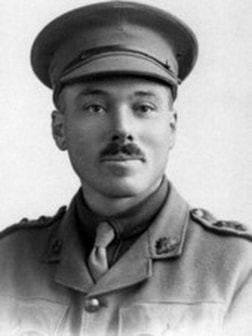
Major
James Logie Harcus
20th Bn. Australian Infantry
11th December 1915, aged 34.
Panel 64.
Son of Andrew and Jane Harcus, of Heatherbank, Westray, Orkney, Scotland.
Picture and Article courtesy of Brian Budge
James was born on the 22nd November 1881 at Heatherbank, Westray, a farm of 32 acres of which 14 were arable. His father, Andrew, had taken over the farm after working as a teacher, but died at Heatherbank of pneumonia when James was only seven years old, leaving his widow, Jane (née Logie), as head of the household including five children. James completed his schooling at Midbea Public School in Westray, then moved into Kirkwall to board with his uncle, George Harcus in Bridge Street Wynd, and started work as an apprentice law clerk. By then James was known to his family and friends as “Hamish”.
On the 31st January 1899 Hamish also started on his other main career path, joining the volunteer gunners in the Orkney Royal Garrison Artillery. Hamish left Orkney on the 12th May 1904 to study law in at Heriot Watt College, Edinburgh and joined Midlothian RGA volunteers on the 22nd May. However on the 29th November Hamish transferred to the 9th Volunteer Battalion (Highlanders), The Royal Scots, passing before King Edward VII in it's ranks during the 1905 Royal Review. Unusually for an Orcadian, Hamish learned to speak Gaelic.
Having completed his law degree, Hamish left London on the 14th June 1907 for Sydney, Australia, where a cousin, George Harcus, already lived. Hamish set to work establishing himself as a Barrister at Law, so it was not until the 19th December 1910 that he found time to obtain a commission in the Scottish Rifles, New South Wales (soon became 25th Infantry).
Hamish had still not married when war broke out, which made it easier for him to give up his legal practice and join the Army. On the 14th August 1914 Hamish applied for a commission in the 1st Contingent , Australian Naval and Military Expeditionary Force and was appointed the rank of Captain on the 18th August. as office commanding the machine gun section , Hamish left Sydney on HMAS "Berrima" the next day and sailed to Rabaul, New Guinea. Hamish's were the only soldiers to take part in the fighting to overpower the German garrison there, the rest being navy men. Hamish returned to Sydney at the end of February 1915.
On the 2nd May 1915 James Harcus was appointed Captain in the Australian Imperial Force and joined its 20th Battalion in 5th Brigade. Hamish was promoted to Major in command of "D" company on the 1st of June, then embarked at Sydney on HMAT A35 "Berrima" on the 26th June for service abroad.
By the time 5th Brigade reached Egypt, the new 2nd Australian Division was forming and completing its training there. However, the 5th Brigade was rushed to Gallipoli to reinforce the tired Anzac and 1st Australian Divisions in their attempt to breakout from the Anzac bridgehead at Sari Bair. When Hamish Harcus landed at Anzac on the 16th August, the main advance on Chunuk Bair had failed, breaking down in confusion in difficult terrain and because of determined Turkish resistance and overwhelming counter-attacks. The 17th and 18th Battalions of the 5th Brigade joined the series of attacks that failed to complete the capture of Hill 60 and lost heavily in the fierce fighting, but the 20th Battalion was spared that ordeal.
By the end of the August the situation at Anzac had reverted back to static trench warfare, with the Turks still holding the vital high ground. The 2nd Australian Division took over most of the defences at Anzac, while the exhausted original Anzac brigades were withdrawn to the nearby island of Lemnos for a rest. The 20th Battalion took over on the 26th August the defences on Russell's Top, where it remained until the withdrawal. Although improved sanitary arrangements lowered sickness rates among the new arrivals, James Harcus was admitted to hospital in the 5th Field Ambulance with dysentery on the 16th October and did not return to his unit until the 1st of November.
The 20th Battalion was dealt a devastating blow on the 11th December, when a Turkish shell burst in one of its saps on Russell’s Top, killing three of its senior officers. They were checking the ground to plan the gradual thinning out of the troops holding the Battalion line prior to the evacuation from Anzac just over a week later. That difficult operation was carried out without discovery by the Turks, but James Harcus did not live to slip away with his company. He and Major Richard Jenkins were killed outright by the exploding shell, while Major Gordon Uther was fatally wounded and died later that day.
James Harcus was 34 years old when he was killed on Russell’s Top on the 11th December 1915. The three brother officers were buried next day in the cemetery at the foot of Walker’s Ridge, but the graves of Majors James Harcus and Richard Jenkins could not be located when the Imperial War Graves Commission consolidated the Anzac cemeteries after the war ended. Their names are therefore commemorated together on Panel 64 of the Lone Pine Memorial.
James Logie Harcus
20th Bn. Australian Infantry
11th December 1915, aged 34.
Panel 64.
Son of Andrew and Jane Harcus, of Heatherbank, Westray, Orkney, Scotland.
Picture and Article courtesy of Brian Budge
James was born on the 22nd November 1881 at Heatherbank, Westray, a farm of 32 acres of which 14 were arable. His father, Andrew, had taken over the farm after working as a teacher, but died at Heatherbank of pneumonia when James was only seven years old, leaving his widow, Jane (née Logie), as head of the household including five children. James completed his schooling at Midbea Public School in Westray, then moved into Kirkwall to board with his uncle, George Harcus in Bridge Street Wynd, and started work as an apprentice law clerk. By then James was known to his family and friends as “Hamish”.
On the 31st January 1899 Hamish also started on his other main career path, joining the volunteer gunners in the Orkney Royal Garrison Artillery. Hamish left Orkney on the 12th May 1904 to study law in at Heriot Watt College, Edinburgh and joined Midlothian RGA volunteers on the 22nd May. However on the 29th November Hamish transferred to the 9th Volunteer Battalion (Highlanders), The Royal Scots, passing before King Edward VII in it's ranks during the 1905 Royal Review. Unusually for an Orcadian, Hamish learned to speak Gaelic.
Having completed his law degree, Hamish left London on the 14th June 1907 for Sydney, Australia, where a cousin, George Harcus, already lived. Hamish set to work establishing himself as a Barrister at Law, so it was not until the 19th December 1910 that he found time to obtain a commission in the Scottish Rifles, New South Wales (soon became 25th Infantry).
Hamish had still not married when war broke out, which made it easier for him to give up his legal practice and join the Army. On the 14th August 1914 Hamish applied for a commission in the 1st Contingent , Australian Naval and Military Expeditionary Force and was appointed the rank of Captain on the 18th August. as office commanding the machine gun section , Hamish left Sydney on HMAS "Berrima" the next day and sailed to Rabaul, New Guinea. Hamish's were the only soldiers to take part in the fighting to overpower the German garrison there, the rest being navy men. Hamish returned to Sydney at the end of February 1915.
On the 2nd May 1915 James Harcus was appointed Captain in the Australian Imperial Force and joined its 20th Battalion in 5th Brigade. Hamish was promoted to Major in command of "D" company on the 1st of June, then embarked at Sydney on HMAT A35 "Berrima" on the 26th June for service abroad.
By the time 5th Brigade reached Egypt, the new 2nd Australian Division was forming and completing its training there. However, the 5th Brigade was rushed to Gallipoli to reinforce the tired Anzac and 1st Australian Divisions in their attempt to breakout from the Anzac bridgehead at Sari Bair. When Hamish Harcus landed at Anzac on the 16th August, the main advance on Chunuk Bair had failed, breaking down in confusion in difficult terrain and because of determined Turkish resistance and overwhelming counter-attacks. The 17th and 18th Battalions of the 5th Brigade joined the series of attacks that failed to complete the capture of Hill 60 and lost heavily in the fierce fighting, but the 20th Battalion was spared that ordeal.
By the end of the August the situation at Anzac had reverted back to static trench warfare, with the Turks still holding the vital high ground. The 2nd Australian Division took over most of the defences at Anzac, while the exhausted original Anzac brigades were withdrawn to the nearby island of Lemnos for a rest. The 20th Battalion took over on the 26th August the defences on Russell's Top, where it remained until the withdrawal. Although improved sanitary arrangements lowered sickness rates among the new arrivals, James Harcus was admitted to hospital in the 5th Field Ambulance with dysentery on the 16th October and did not return to his unit until the 1st of November.
The 20th Battalion was dealt a devastating blow on the 11th December, when a Turkish shell burst in one of its saps on Russell’s Top, killing three of its senior officers. They were checking the ground to plan the gradual thinning out of the troops holding the Battalion line prior to the evacuation from Anzac just over a week later. That difficult operation was carried out without discovery by the Turks, but James Harcus did not live to slip away with his company. He and Major Richard Jenkins were killed outright by the exploding shell, while Major Gordon Uther was fatally wounded and died later that day.
James Harcus was 34 years old when he was killed on Russell’s Top on the 11th December 1915. The three brother officers were buried next day in the cemetery at the foot of Walker’s Ridge, but the graves of Majors James Harcus and Richard Jenkins could not be located when the Imperial War Graves Commission consolidated the Anzac cemeteries after the war ended. Their names are therefore commemorated together on Panel 64 of the Lone Pine Memorial.

415 Private
Richard Alexander Jarman
2nd Bn. Australian Infantry, A.I.F.
29th April 1915.
Panel 18.
Studio portrait of 415 Private (Pte) Richard Alexander Jarman, D Company, 2nd Battalion, of Tamworth, NSW. Pte Jarman enlisted on 17 August 1914 and embarked from Sydney aboard HMAT Suffolk on 18 October 1914. He was wounded at Gallipoli Peninsula and died of wounds received on 29 April 1915, aged 23 years. He died on the Hospital ship Galeka and was buried at sea. He is memorialised at Lone Pine Memorial Gallipoli Peninsula.
Richard Alexander Jarman
2nd Bn. Australian Infantry, A.I.F.
29th April 1915.
Panel 18.
Studio portrait of 415 Private (Pte) Richard Alexander Jarman, D Company, 2nd Battalion, of Tamworth, NSW. Pte Jarman enlisted on 17 August 1914 and embarked from Sydney aboard HMAT Suffolk on 18 October 1914. He was wounded at Gallipoli Peninsula and died of wounds received on 29 April 1915, aged 23 years. He died on the Hospital ship Galeka and was buried at sea. He is memorialised at Lone Pine Memorial Gallipoli Peninsula.
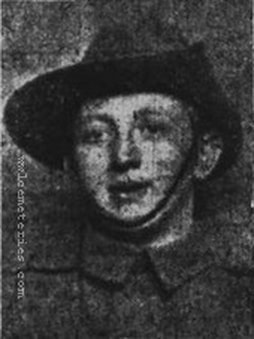
517 Private
Harold Keers
15th Bn. Australian Infantry, A.I.F.
8th August 1915.
Panel 46.
Harold Keers
15th Bn. Australian Infantry, A.I.F.
8th August 1915.
Panel 46.

32 Lance Corporal
Harry Linklater
18th Bn. Australian Infantry,
22nd August 1915, aged 25.
Panel 60.
Son of George and Mary Linklater, of Fillets, Graemsay, Orkney Islands, Scotland.
Picture and Article courtesy of Brian Budge
Harry was born on the small Orkney island of Graemsay on the 20th January 1890, registered at birth as Henry. His parents, George Linklater and Mary Linklater (née Thomson), farmed 36 acres at Fillets and employed a farm servant and dairymaid. Harry had an older sister, Alice, and younger sister, Catherine, also three older brothers, James, John and Joseph.
Harry’s mother had been a dressmaker before she married, which probably influenced him to train as a draper in George Thomson’s shop in Stromness. Harry also served 4 years in the Stromness Company of the Orkney Royal Garrison Artillery (Territorial Force). When aged 23, Harry followed his brother James and travelled out to Sydney, Australia. Harry was employed as a draper in Sydney’s largest and most diverse department store, Anthony Hordern and Sons’ New Palace Emporium. In 1905 the company replaced a store destroyed by fire in 1901 with a building that occupied an entire city block and employed about 3,000 people.
Harry enlisted in the Australian Imperial Force on the 27th February 1915, 18th Battalion, 5th Brigade formed at Liverpool, New South Wales on the 1st March. When the 18th Battalion left Sydney on HMAT A40 "Ceramic" on the 28th June, Harry held the rank of Lance Corporal and had trained as a signaller. He spent only a short time in Egypt, embarked for Gallipoli on the 16th August. The 18th and 19th Battalions came ashore at Anzac cove on the night of the 19th, as the first two units of the Australian 2nd Division, and they spent a day near the foot of the Sphinx.
The last offensive to drive the Turks off the Sari Bair heights had already failed in the face of fierce resistance and overwhelming counter–attacks, when the 5th Brigade concentrated below Walker’s Ridge. Anzac troops were still on the offensive, to connect the north of their beachhead to a new British landing site at Sulva. After fierce fighting on the 21st August, Anzac and British troops had gained only a couple of footholds on Hill 60, at heavy cost.
Harry was posted missing on the 22nd August. A court of enquiry, held at Tel el Kebir in Egypt after the Gallipoli evacuation, found it reasonable to suppose Harry Linklater was killed in action on the 22nd August 1915. A signaller friend, Arthur Hall, reported that during the charge on Hill 60, he passed Harry lying on the ground. Harry seemed to have been hit on the left side of the head and appeared dead. Harry is commemorated on Panel 60 of the Lone Pine Memorial in Gallipoli, but he is probably one of the 712 unidentified burials in Hill 60 Cemetery. Harry Linklater’s photo at the top of this page is taken from a montage Honour Board that commemorates 46 of the 48 employees of the Sydney department store Anthony Hordern and Sons Ltd., who died serving in the First World War.
Harry Linklater
18th Bn. Australian Infantry,
22nd August 1915, aged 25.
Panel 60.
Son of George and Mary Linklater, of Fillets, Graemsay, Orkney Islands, Scotland.
Picture and Article courtesy of Brian Budge
Harry was born on the small Orkney island of Graemsay on the 20th January 1890, registered at birth as Henry. His parents, George Linklater and Mary Linklater (née Thomson), farmed 36 acres at Fillets and employed a farm servant and dairymaid. Harry had an older sister, Alice, and younger sister, Catherine, also three older brothers, James, John and Joseph.
Harry’s mother had been a dressmaker before she married, which probably influenced him to train as a draper in George Thomson’s shop in Stromness. Harry also served 4 years in the Stromness Company of the Orkney Royal Garrison Artillery (Territorial Force). When aged 23, Harry followed his brother James and travelled out to Sydney, Australia. Harry was employed as a draper in Sydney’s largest and most diverse department store, Anthony Hordern and Sons’ New Palace Emporium. In 1905 the company replaced a store destroyed by fire in 1901 with a building that occupied an entire city block and employed about 3,000 people.
Harry enlisted in the Australian Imperial Force on the 27th February 1915, 18th Battalion, 5th Brigade formed at Liverpool, New South Wales on the 1st March. When the 18th Battalion left Sydney on HMAT A40 "Ceramic" on the 28th June, Harry held the rank of Lance Corporal and had trained as a signaller. He spent only a short time in Egypt, embarked for Gallipoli on the 16th August. The 18th and 19th Battalions came ashore at Anzac cove on the night of the 19th, as the first two units of the Australian 2nd Division, and they spent a day near the foot of the Sphinx.
The last offensive to drive the Turks off the Sari Bair heights had already failed in the face of fierce resistance and overwhelming counter–attacks, when the 5th Brigade concentrated below Walker’s Ridge. Anzac troops were still on the offensive, to connect the north of their beachhead to a new British landing site at Sulva. After fierce fighting on the 21st August, Anzac and British troops had gained only a couple of footholds on Hill 60, at heavy cost.
Harry was posted missing on the 22nd August. A court of enquiry, held at Tel el Kebir in Egypt after the Gallipoli evacuation, found it reasonable to suppose Harry Linklater was killed in action on the 22nd August 1915. A signaller friend, Arthur Hall, reported that during the charge on Hill 60, he passed Harry lying on the ground. Harry seemed to have been hit on the left side of the head and appeared dead. Harry is commemorated on Panel 60 of the Lone Pine Memorial in Gallipoli, but he is probably one of the 712 unidentified burials in Hill 60 Cemetery. Harry Linklater’s photo at the top of this page is taken from a montage Honour Board that commemorates 46 of the 48 employees of the Sydney department store Anthony Hordern and Sons Ltd., who died serving in the First World War.
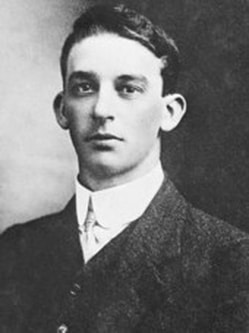
710 Lance Sergeant
Ian Gordon MacInnes
2nd Bn. Australian Infantry,
between 25th April 1915 and 30th April 1915, aged 30.
Panel 17.
Son of the Rev. George MacInnes, D.D. and Margaret MacInnes, of 45, Liverpool Rd., Summer Hill, New South Wales. Native of Ashfield.
Studio portrait of 710 Lance Sergeant (L Sgt) Ian Gordon MacInnes, 2nd Battalion from Summer Hill, NSW wearing civilian clothing. A 30 year old bank clerk prior to enlisting on 29 August 1914, he embarked for overseas service with G Company from Sydney aboard HMAT Suffolk (A23) on 18 October 1914. Soon after the landing at Anzac, he is reported to have taken part in the charge on Sunday afternoon 25 April 1915 to the far side of Lone Pine. When the others were compelled to retire, he was not seen again. L Sgt MacInnes is commemorated on the Lone Pine Memorial, Gallipoli, Turkey with others who have no known grave. His brother, Captain Angus MacInnes, Australian Army Medical Corps also served and returned to Australia.
Ian Gordon MacInnes
2nd Bn. Australian Infantry,
between 25th April 1915 and 30th April 1915, aged 30.
Panel 17.
Son of the Rev. George MacInnes, D.D. and Margaret MacInnes, of 45, Liverpool Rd., Summer Hill, New South Wales. Native of Ashfield.
Studio portrait of 710 Lance Sergeant (L Sgt) Ian Gordon MacInnes, 2nd Battalion from Summer Hill, NSW wearing civilian clothing. A 30 year old bank clerk prior to enlisting on 29 August 1914, he embarked for overseas service with G Company from Sydney aboard HMAT Suffolk (A23) on 18 October 1914. Soon after the landing at Anzac, he is reported to have taken part in the charge on Sunday afternoon 25 April 1915 to the far side of Lone Pine. When the others were compelled to retire, he was not seen again. L Sgt MacInnes is commemorated on the Lone Pine Memorial, Gallipoli, Turkey with others who have no known grave. His brother, Captain Angus MacInnes, Australian Army Medical Corps also served and returned to Australia.

72 Lance Corporal
Eugene Patrick Mahony
2nd Bn. Australian Infantry, A.I.F.
20th May 1915.
Panel 16.
Studio portrait of Eugene Patrick Mahony, 2nd Battalion. A plumber of Armidale NSW, he enlisted on 17 August 1914 and with the service number 72 and the rank of Lance Corporal, he sailed with A Company aboard HMAT Suffolk on 18 October 1914. He was wounded while serving on the Gallipoli Peninsula on 18 May 1915 and later died from his wounds at sea, aged 25, on 20 May 1915. He is commemorated on the Lone Pine Memorial, Gallipoli Peninsula.
Eugene Patrick Mahony
2nd Bn. Australian Infantry, A.I.F.
20th May 1915.
Panel 16.
Studio portrait of Eugene Patrick Mahony, 2nd Battalion. A plumber of Armidale NSW, he enlisted on 17 August 1914 and with the service number 72 and the rank of Lance Corporal, he sailed with A Company aboard HMAT Suffolk on 18 October 1914. He was wounded while serving on the Gallipoli Peninsula on 18 May 1915 and later died from his wounds at sea, aged 25, on 20 May 1915. He is commemorated on the Lone Pine Memorial, Gallipoli Peninsula.
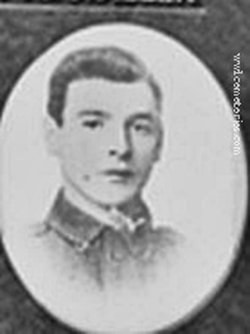
489 Private
Michael Malloy
1st Bn. Australian Infantry, A.I.F.
23rd May 1915.
Panel 15.
C. 1914. A portrait of 489 Private Michael Malloy, 1st Battalion. Private Malloy died of wounds at sea on 1915-05-23. His name is listed on the Lone Pine Memorial, Gallipoli, Turkey.
Michael Malloy
1st Bn. Australian Infantry, A.I.F.
23rd May 1915.
Panel 15.
C. 1914. A portrait of 489 Private Michael Malloy, 1st Battalion. Private Malloy died of wounds at sea on 1915-05-23. His name is listed on the Lone Pine Memorial, Gallipoli, Turkey.
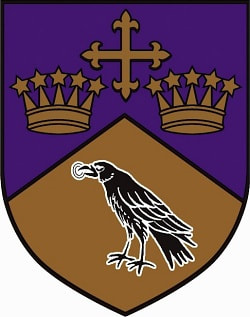
813 Private
Gilbert Andinwood Orchard
11th Bn. Australian Infantry, A.I.F.
29th April 1915.
Panel 34.
The information below supplied by 'The Ellesmerian Club', the alumni organisation for Ellesmere College where Gilbert was a pupil.
Gilbert Andinwood Orchard
11th Bn. Australian Infantry, A.I.F.
29th April 1915.
Panel 34.
The information below supplied by 'The Ellesmerian Club', the alumni organisation for Ellesmere College where Gilbert was a pupil.
Gilbert Audinwood Orchard, one of two sons of Reverend James Orchard and his wife, Annie, was kept in order by his three sisters Beatrice, Annie and Barbara. He was born in North Adelaide, Australia on 20thNovember 1882 whilst his father was a missionary in the country. He received a basic education in the early years of his life but, with the lack of any established educational institutions in the country, he was sent to England when eleven years old.
Thus it was that on January 1897, along with thirty nine other new boys, Gilbert was admitted to Ellesmere College. He was allocated to the ‘Heywood’ dormitory and boarded for precisely one term, managing a solitary mention in The Ellesmerian of the time which simply mentioned he had entered the college. Passenger manifest lists for that year show that in April he, along with his sisters Beatrice (18) and Annie (19) were on ss Orient for the return voyage to Australia.
To date, very little has been discovered about his life or career prior to August 1914 when he signed his Attestation Papers at Black Boy Hill, Western Australia to become Private Orchard, Service No: 813, the Australian Imperial Force. His mother died in 1901, his father in 1908 and he was employed for some time in Swan, wellington as a clerk. At the time of his enlistment he was a surveyor’s assistant.
On his Attestation documents he declared he was a surveyor’s assistant, single and had some previous military experience with the Bunbury Infantry, a voluntary unit that had been created following the withdrawal of British garrison troops from the Australian colonies. He was thirty years old and gave his next of kin as his sister, Trixie (Beatrice) who lived in Perth. His sister Annie Marie was, at that time, resident in London.
He was embodied on 10th September to ‘D’ Company, the 11th Infantry Battalion, the 3rd Brigade but it would appear he did not immediately settle into the ‘Army’ way of life as on 4th October he forfeited a day’s pay and was confined to barracks for three days for being absent without leave. The end of the month saw him embark on the troopship “Ascandius” at Freemantle for the long voyage to England.
Four months later, on 2nd March 1915, he again embarked on another sea crossing, this time on the troopship “Suffolk” to join the Mesopotamian Expeditionary Force (Gallipoli Peninsula) at Alexandria.
His exact movements are unknown due to the scarcity of records but only a few weeks after arriving he was killed on 29th April – one of five hundred and fourteen men to die on that day in the war.
Gilbert’s body was never recovered and his sacrifice is recorded on the Lone Pine Memorial, the main Australian Memorial on the Gallipoli Peninsula. He was awarded the Victory Medal, the British War Medal and the 1914/1915 Star.
In October 1916 his elder sister, Trixie, married. Her bouquet was made of red roses from Jarrahdale where Gilbert had lived prior to his enlistment.
Gilbert’s brother, Lieutenant Geoffrey Duncan, died of wounds sustained at Rouen on 15th October 1918 and is buried in St. Sever Cemetery Extension
Thus it was that on January 1897, along with thirty nine other new boys, Gilbert was admitted to Ellesmere College. He was allocated to the ‘Heywood’ dormitory and boarded for precisely one term, managing a solitary mention in The Ellesmerian of the time which simply mentioned he had entered the college. Passenger manifest lists for that year show that in April he, along with his sisters Beatrice (18) and Annie (19) were on ss Orient for the return voyage to Australia.
To date, very little has been discovered about his life or career prior to August 1914 when he signed his Attestation Papers at Black Boy Hill, Western Australia to become Private Orchard, Service No: 813, the Australian Imperial Force. His mother died in 1901, his father in 1908 and he was employed for some time in Swan, wellington as a clerk. At the time of his enlistment he was a surveyor’s assistant.
On his Attestation documents he declared he was a surveyor’s assistant, single and had some previous military experience with the Bunbury Infantry, a voluntary unit that had been created following the withdrawal of British garrison troops from the Australian colonies. He was thirty years old and gave his next of kin as his sister, Trixie (Beatrice) who lived in Perth. His sister Annie Marie was, at that time, resident in London.
He was embodied on 10th September to ‘D’ Company, the 11th Infantry Battalion, the 3rd Brigade but it would appear he did not immediately settle into the ‘Army’ way of life as on 4th October he forfeited a day’s pay and was confined to barracks for three days for being absent without leave. The end of the month saw him embark on the troopship “Ascandius” at Freemantle for the long voyage to England.
Four months later, on 2nd March 1915, he again embarked on another sea crossing, this time on the troopship “Suffolk” to join the Mesopotamian Expeditionary Force (Gallipoli Peninsula) at Alexandria.
His exact movements are unknown due to the scarcity of records but only a few weeks after arriving he was killed on 29th April – one of five hundred and fourteen men to die on that day in the war.
Gilbert’s body was never recovered and his sacrifice is recorded on the Lone Pine Memorial, the main Australian Memorial on the Gallipoli Peninsula. He was awarded the Victory Medal, the British War Medal and the 1914/1915 Star.
In October 1916 his elder sister, Trixie, married. Her bouquet was made of red roses from Jarrahdale where Gilbert had lived prior to his enlistment.
Gilbert’s brother, Lieutenant Geoffrey Duncan, died of wounds sustained at Rouen on 15th October 1918 and is buried in St. Sever Cemetery Extension
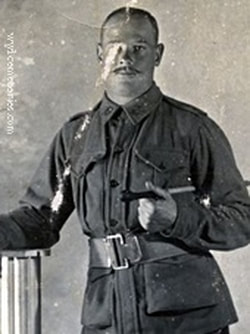
330 Private
Oliver James Osborn
2nd Bn. Australian Infantry, A.I.F.
2nd May 1915.
Panel 18.
Studio portrait of 330 Private (Pte) Oliver James Osborn, 2nd Battalion. A mechanic prior to enlisting on 17 August 1914, Pte Osborn embarked for overseas service aboard HMAT Suffolk (A23) on 18 October 1914. He was killed in action on the Gallipoli Peninsula on 2 May 1915, aged 24 years.
Oliver James Osborn
2nd Bn. Australian Infantry, A.I.F.
2nd May 1915.
Panel 18.
Studio portrait of 330 Private (Pte) Oliver James Osborn, 2nd Battalion. A mechanic prior to enlisting on 17 August 1914, Pte Osborn embarked for overseas service aboard HMAT Suffolk (A23) on 18 October 1914. He was killed in action on the Gallipoli Peninsula on 2 May 1915, aged 24 years.

429 Private
Hugh Arthur Phillpotts
18th Bn. Australian Infantry, A.I.F.
22nd August 1915, aged 20.
Panel 62.
Son of Arthur Charles and Anne Phillpotts. Native of Devon, England.
The information below supplied by 'The Ellesmerian Club', the alumni organisation for Ellesmere College where Hugh was a pupil.
Hugh Arthur Phillpotts
18th Bn. Australian Infantry, A.I.F.
22nd August 1915, aged 20.
Panel 62.
Son of Arthur Charles and Anne Phillpotts. Native of Devon, England.
The information below supplied by 'The Ellesmerian Club', the alumni organisation for Ellesmere College where Hugh was a pupil.
Hugh Arthur Phillpotts died on 22nd August 1915. His life was short and troubled. He was born on 4thJanuary 1895 to Arthur Charles and Annie Kezia in Exmouth, Devon. His father gave his occupation as a merchant on his marriage lines of 31st March 1894. The wedding was celebrated in Westbury, Wiltshire; his mother coming from Slimbridge, Gloucestershire. His father had been born in Jamaica.
By the 1901 Census the family had moved to London. The marriage was, however, in difficulties. Annie had met Albert Moore Orlando Richards and was spending more time with him than her family. Albert’s wife, Edith Richards, had sued him for divorce on the grounds of his cruelty and adultery with “a woman whose name is believed to Margaret Hathaway or Phillpotts”. Annie was certainly calling herself the wife of Albert in the 1901 Census. She became legally Mrs Richards in the winter of 1902.
Arthur was granted custody of his son who was now approaching six. He did not remain with him for long. On 18th February 1903 he went on board the “Tagus” and left for Jamaica. There is no suggestion that he returned to England. The eight year old Hugh was left in the care of his great aunt, Susannah Phillpotts, who appears in many documents as Susan.
Before coming to Ellesmere College Hugh spent two terms at King’s College, Taunton. His aunt was living there at the time having moved from London sometime in 1904. Hugh joined the College in September 1905. Initially he was in Harold Dormitory but by 1909 he had moved to Arthur. He represented his dormitories at the usual sports of cricket, hockey and soccer, never, however, on the winning side. He had a minor role in A Midsummer Night’s Dream (1907) and he sang two songs in As You like It (1909). Hugh won three prizes: for Declamation (1907); the Headmaster’s Prize for Wild Flowers (1909); and Lower IV English (1910).
Hugh returned to Taunton College after leaving Ellesmere. He was soon on the move once more. This time for Australia, quite possibly arriving in 1913. Two years later he was heading for Europe as a signaller, Service No. 429, with “C” Company, 18th Battalion, Australian Imperial Force. After an uneventful voyage the ‘Ceramic’ arrived in Egypt where, after four weeks, orders were issued to prepare for embarkation to Gallipoli to reinforce the men already there. The early August assaults on Lone Pine and the Nek had taken their toll and the powers that be still believed a breakthrough was possible.
Three days after landing at Suvla Bay at daybreak on Sunday, 22nd August, the Battalion went into action at Hill 60. Many of the men were not aware that they were to assault Hill 60 until just before 5.00am that morning. Hill 60 was considered of strategic importance for two reasons. Firstly, it overlooked much of the Anzac positions and, secondly, whoever held it also controlled two wells that supplied water.
As it came out into the open, the battalion was mowed down by machine gun fire. Fifty per cent of the attackers were casualties. “There were thousands of bodies lying between the trenches and the Turks set fire to the gorse to burn the bodies and rid the place of the fearful stench which was almost unbearable.” (Statement by a Sergeant of the 18th Battalion, made from Luna Park Hospital, Heliopolis, Cairo, 26thDecember 1915). One of the casualties was Hugh. His body was never recovered; possibly destroyed by the Turks burning the gorse.
This was not quite the end, however, as the Australian Red Cross started investigations. An “informant” (Private W. Stevens) stated that on August 22nd 1915 at Hill 60, Phillpotts was wounded, got better and joined the Regiment again in Egypt. He was made Sergeant in France and wounded again on 4th August 1916. The informant saw him going to the dressing station on August 5th 1916 and has not seen or heard of him since.” Several other witnesses submitted a statement but the Board of Inquiry set up in September 1916 decided unanimously “that it is reasonable to presume that this man is killed in action.” His aunt, Miss Susan Phillpotts, was informed of his death and sent a copy of the pamphlet “Where the Australians Rest”.
She died in 1920 so what happened to Hugh’s medals (the 1914-15 Star, the British War Medal, the Victory Medal, the Memorial Plaque and Scroll) which were sent to her on 7th April 1922 is unknown.
Hugh’s name is recorded on Panel 62 of Lone Pine Memorial. This Memorial stands on the site of the fiercest fighting at Lone Pine and overlooks the whole front line of May 1915. It commemorates more than 4,900 Australian and New Zealand servicemen. His sacrifice is also commemorated on Memorials at Ellesmere College and King’s College, Taunton.
By the 1901 Census the family had moved to London. The marriage was, however, in difficulties. Annie had met Albert Moore Orlando Richards and was spending more time with him than her family. Albert’s wife, Edith Richards, had sued him for divorce on the grounds of his cruelty and adultery with “a woman whose name is believed to Margaret Hathaway or Phillpotts”. Annie was certainly calling herself the wife of Albert in the 1901 Census. She became legally Mrs Richards in the winter of 1902.
Arthur was granted custody of his son who was now approaching six. He did not remain with him for long. On 18th February 1903 he went on board the “Tagus” and left for Jamaica. There is no suggestion that he returned to England. The eight year old Hugh was left in the care of his great aunt, Susannah Phillpotts, who appears in many documents as Susan.
Before coming to Ellesmere College Hugh spent two terms at King’s College, Taunton. His aunt was living there at the time having moved from London sometime in 1904. Hugh joined the College in September 1905. Initially he was in Harold Dormitory but by 1909 he had moved to Arthur. He represented his dormitories at the usual sports of cricket, hockey and soccer, never, however, on the winning side. He had a minor role in A Midsummer Night’s Dream (1907) and he sang two songs in As You like It (1909). Hugh won three prizes: for Declamation (1907); the Headmaster’s Prize for Wild Flowers (1909); and Lower IV English (1910).
Hugh returned to Taunton College after leaving Ellesmere. He was soon on the move once more. This time for Australia, quite possibly arriving in 1913. Two years later he was heading for Europe as a signaller, Service No. 429, with “C” Company, 18th Battalion, Australian Imperial Force. After an uneventful voyage the ‘Ceramic’ arrived in Egypt where, after four weeks, orders were issued to prepare for embarkation to Gallipoli to reinforce the men already there. The early August assaults on Lone Pine and the Nek had taken their toll and the powers that be still believed a breakthrough was possible.
Three days after landing at Suvla Bay at daybreak on Sunday, 22nd August, the Battalion went into action at Hill 60. Many of the men were not aware that they were to assault Hill 60 until just before 5.00am that morning. Hill 60 was considered of strategic importance for two reasons. Firstly, it overlooked much of the Anzac positions and, secondly, whoever held it also controlled two wells that supplied water.
As it came out into the open, the battalion was mowed down by machine gun fire. Fifty per cent of the attackers were casualties. “There were thousands of bodies lying between the trenches and the Turks set fire to the gorse to burn the bodies and rid the place of the fearful stench which was almost unbearable.” (Statement by a Sergeant of the 18th Battalion, made from Luna Park Hospital, Heliopolis, Cairo, 26thDecember 1915). One of the casualties was Hugh. His body was never recovered; possibly destroyed by the Turks burning the gorse.
This was not quite the end, however, as the Australian Red Cross started investigations. An “informant” (Private W. Stevens) stated that on August 22nd 1915 at Hill 60, Phillpotts was wounded, got better and joined the Regiment again in Egypt. He was made Sergeant in France and wounded again on 4th August 1916. The informant saw him going to the dressing station on August 5th 1916 and has not seen or heard of him since.” Several other witnesses submitted a statement but the Board of Inquiry set up in September 1916 decided unanimously “that it is reasonable to presume that this man is killed in action.” His aunt, Miss Susan Phillpotts, was informed of his death and sent a copy of the pamphlet “Where the Australians Rest”.
She died in 1920 so what happened to Hugh’s medals (the 1914-15 Star, the British War Medal, the Victory Medal, the Memorial Plaque and Scroll) which were sent to her on 7th April 1922 is unknown.
Hugh’s name is recorded on Panel 62 of Lone Pine Memorial. This Memorial stands on the site of the fiercest fighting at Lone Pine and overlooks the whole front line of May 1915. It commemorates more than 4,900 Australian and New Zealand servicemen. His sacrifice is also commemorated on Memorials at Ellesmere College and King’s College, Taunton.
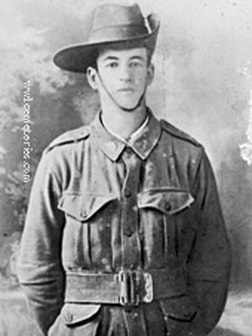
981 Private
Charles Howard Proctor
2nd Bn. Australian Infantry, A.I.F.
2nd May 1915, aged 23.
Panel 18.
Son of Richard and Elizabeth Proctor, of West Maitland New South Wales.
Studio portrait of 981 Private (Pte) Charles Howard Proctor, 2nd Battalion. Pte Proctor, a surveyor from West Maitland, NSW, enlisted with the AIF in September 1914, and embarked with A Company on HMAT Suffolk on 18 October 1914. Pte Proctor was killed in action at Gallipoli on 2 May 1915. He was 23 years old.
Charles Howard Proctor
2nd Bn. Australian Infantry, A.I.F.
2nd May 1915, aged 23.
Panel 18.
Son of Richard and Elizabeth Proctor, of West Maitland New South Wales.
Studio portrait of 981 Private (Pte) Charles Howard Proctor, 2nd Battalion. Pte Proctor, a surveyor from West Maitland, NSW, enlisted with the AIF in September 1914, and embarked with A Company on HMAT Suffolk on 18 October 1914. Pte Proctor was killed in action at Gallipoli on 2 May 1915. He was 23 years old.
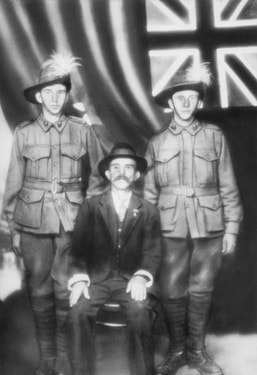
359 Private
George Ernest Watts
15th Bn., Australian Infantry, A.I.F.
9th May 1915, aged 22.
Panel 50.
Son of Ernest George Watts, of "Allies," Howard St., Rosalie, Queensland. Native of Brisbane.
Click on image to enlarge
Studio portrait of 358 Private (Pte) Frederick Watts (left) and 359 Pte George Ernest Watts (right) with their father Ernest George Watts. Both men were grooms from Ascot, Queensland prior to enlistment and embarked with B Company, 15th Battalion from Melbourne on HMAT Ceramic on 22 December 1914. Pte Frederick Watts was wounded in action at Gallipoli and, following his return to duty was awarded the Military Medal "for conspicuous gallantry in action near Villers-Bretonneux....His cheerfulness and gallantry throughout the tour of duty in the line greatly inspired all the men around him." Later promoted to Lance Sergeant, he died of wounds received in action and was buried in the Hancourt British Cemetery, France. Pte George Watts was killed in action at Gallipoli on 9 May 1915 and, having no known grave, is commemorated on the Lone Pine Memorial.
George Ernest Watts
15th Bn., Australian Infantry, A.I.F.
9th May 1915, aged 22.
Panel 50.
Son of Ernest George Watts, of "Allies," Howard St., Rosalie, Queensland. Native of Brisbane.
Click on image to enlarge
Studio portrait of 358 Private (Pte) Frederick Watts (left) and 359 Pte George Ernest Watts (right) with their father Ernest George Watts. Both men were grooms from Ascot, Queensland prior to enlistment and embarked with B Company, 15th Battalion from Melbourne on HMAT Ceramic on 22 December 1914. Pte Frederick Watts was wounded in action at Gallipoli and, following his return to duty was awarded the Military Medal "for conspicuous gallantry in action near Villers-Bretonneux....His cheerfulness and gallantry throughout the tour of duty in the line greatly inspired all the men around him." Later promoted to Lance Sergeant, he died of wounds received in action and was buried in the Hancourt British Cemetery, France. Pte George Watts was killed in action at Gallipoli on 9 May 1915 and, having no known grave, is commemorated on the Lone Pine Memorial.




